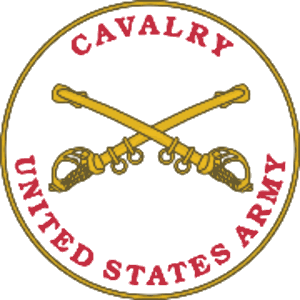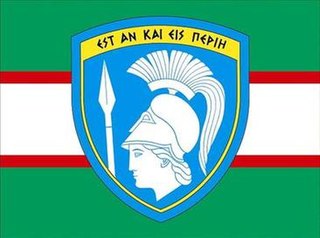A division is a large military unit or formation, usually consisting of between 10,000 and 25,000 soldiers. In most armies, a division is composed of several regiments or brigades; in turn, several divisions typically make up a corps.

The 1st Infantry Division (1ID) is a combined arms division of the United States Army, and is the oldest continuously serving division in the Regular Army. It has seen continuous service since its organization in 1917 during World War I. It was officially nicknamed "The Big Red One" after its shoulder patch and is also nicknamed "The Fighting First." The division has also received troop monikers of "The Big Dead One" and "The Bloody First" as puns on the respective officially sanctioned nicknames. It is currently based at Fort Riley, Kansas.

The 4th Infantry Division is a division of the United States Army based at Fort Carson, Colorado. It is composed of a division headquarters battalion, three brigade combat teams, a combat aviation brigade, a division sustainment brigade, and a division artillery.

The VII Army Corps of the United States Army was one of the two principal corps of the United States Army Europe during the Cold War. Activated in 1918 for World War I, it was reactivated for World War II and again during the Cold War. During both World War II and the Cold War it was subordinate to the Seventh Army, or USAREUR and was headquartered at Kelley Barracks in Stuttgart, West Germany, from 1951 until it was redeployed to the US after significant success in the Gulf War in 1991, then inactivated in 1992.

The 9th Infantry Division is an inactive infantry division of the United States Army. It was formed as the 9th Division during World War I, but never deployed overseas. In later years it was an important unit of the U.S. Army during World War II and the Vietnam War. It was also activated as a peacetime readiness unit from 1947 to 1962 at Fort Dix, New Jersey, and Fort Carson, Colorado, and from 1972 to 1991 as an active-duty infantry division at Fort Lewis, Washington. The division was inactivated in December 1991.

The United States Cavalry, or U.S. Cavalry, was the designation of the mounted force of the United States Army. The United States Cavalry was formally created by an act of Congress on 3 August 1861 and ceased as a distinct Army branch in 1942. The name "cavalry" continues to be used as a designation for various specific United States Army formations and functions.
The 12th Cavalry is a cavalry regiment of the United States Army. It is currently stationed at Fort Cavazos.
The United States Army Regimental System (USARS) is an organizational and classification system used by the United States Army. It was established in 1981 to replace the Combat Arms Regimental System (CARS) to provide each soldier with continuous identification with a single regiment, and to increase a soldier's probability of serving recurring assignments with their regiment. The USARS was intended to enhance combat effectiveness by providing the opportunity for a regimental affiliation, thus obtaining some of the benefits of the traditional regimental system.

The 2nd Mechanized Infantry Division is a mechanized infantry division of the Hellenic Army.
Combined Joint Task Force 7 was the interim military formation that directed the U.S. effort in Iraq between June 2003 and May 2004. It replaced the Coalition Forces Land Component Command on 14 June 2003. CFLCC was the land forces component of United States Central Command that carried out the initial invasion of Iraq, was established by Commander, U.S. Army Forces Central Command, in 2002/3, to oversee two corps-sized organizations, I Marine Expeditionary Force and V Corps. These two corps-level formations carried out Operation Iraqi Freedom which began on 20 March 2003.

This is the order of battle for the invasion of Iraq during the Iraq War between coalition forces and the Iraqi Armed Forces; Fedayeen Saddam irregulars; and others between March 19 and May 1, 2003.
This article provides formation lists of the Polish People's Army order of battle at various points in history between 1943 and 1989.

Ramadi, the capital of Iraq's Al Anbar Governorate, was under U.S. military occupation during the Iraq War. It was a focal point of Iraqi insurgency, which erupted into open armed conflict in 2004 and in 2006, part of the Iraq War in Anbar Province. Operation Murfreesboro was a U.S. offensive in February 2007 intended to cut off the Ma'Laab district of eastern Ramadi from the rest of the town in order to drive out Zarqawi's Al-Qaeda in Iraq.

The V Army Corps was one of three corps the Italian Army fielded during the Cold War. Based in the regions of Veneto and Friuli-Venezia-Giulia the corps was the army's main combat force. The 5th Army Corps was arrayed close to the Yugoslavian border and tasked with meeting any Warsaw Pact forces that crossed the border. On the left flank of the corps the 4th Alpine Army Corps was tasked with blocking the Alpine passes and in the rear of the corps the 3rd Army Corps served as operational reserve. After the end of the Cold War the corps was reduced in size and on 1 October 1997 it became the 1st Defence Forces Command. In 2013 the COMFOD 1° was disbanded and its function and brigades taken over by the 20th Infantry Division Friuli in Florence.
The following is a hierarchical outline for the Italian Army at the end of the Cold War. It is intended to convey the connections and relationships between units and formations.











